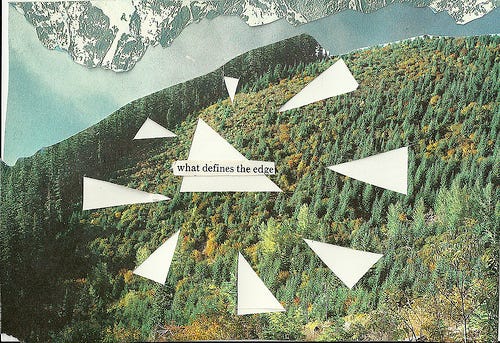🍄 Enter the Quantum Mind
Neuroscientists, psychologists, and brain researchers have been struggling, in vain, to explain the phenomenon of consciousness. Will the quantum mind open the door to understanding this enigma?
From the minds of Sputnik Futures. Exploring every rabbit hole there is. For more wanderings, become an Alice in Futureland subscriber—it's free.
🍄 AudioDose: this is Alice on Sonic Mushrooms. Quantum tuning here.
🎧 Alice in Futureland Podcasts
📘 ALICE book Tuning into Frequency: The invisible force that heals us and the planet.
Hello, we’re Alice, and we are always in a state of wander. Multiverses have us all a-Marvel: nineties TV favorite, Quantum Leap, just had a Netflix remake and multi-Oscar-winning movie, Everything Everywhere All at Once [2022], continues to clock-up ideas of time-travel and parallel ’verse-shifting.’ The ‘block universe theory’—an idea that the past, present and future exist all at once—flips into a scene of ‘Fleishman Is In Trouble,’ the Disney Plus adaptation of Taffy Brodesser-Akner’s New York Times bestselling book. But it’s all just the stuff of sci-fi, right? Or wishful thinking, like the ‘thoughts become things’ and ‘mind over matter’ mantras that spread #goodvibesonly across Instagram. Well, #manifesting is no longer The Secret it was back in the noughties, with speeches by self-help hit Esther Hicks now trending on TikTok, and celebrities selling the science of ‘speaking it into being.’ “You have to believe that that’s your future, so much so that the trillion cells in your body start to do the things that it takes to get there,” chart-topping singer/songwriter Jason Derulo told the Happy Place podcast in July.
“If you do not get schwindlig [dizzy] sometimes when you think about these things then you have not really understood it.”– Physicist Niels Bohr, on quantum theory.
Believe It Or Not …
… All of the above comes down to Quantum Physics, also known as Quantum Mechanics. It’s the study of atoms and subatomic particles at the deepest layer of reality we know, and how they interact. More precisely, it comes down to ‘quantum entanglement,’ the theory that particles once combined can instantly influence each other, no matter the distance. Some scientists dream that entangled particles could one day create an impenetrable communications system – and others are just happy to be getting to the very bottom of things.
‘The idea of the universe as an interconnected whole is not new; for millennia it's been one of the core assumptions of Eastern philosophies,’ writes Dean Radin in Entangled Minds: Extrasensory Experiences in a Quantum Reality. ‘What is new is that Western science is slowly beginning to realize that some elements of that ancient lore might be correct.’
Before we leap off over there (and everywhere, with ‘quantum teleportation’), let’s get a grasp on consciousness, with a jump into…
The Great Unknown
“The day science starts to study non-physical phenomena, it will make more progress in one decade than in all the previous centuries of its existence.”
—Nikola Tesla, inventor
Humans have always been caught up – and caught out – by the idea of consciousness, which is dictionary-defined as ‘the state of understanding and realizing something.’ ‘While neuroscience can explain with growing precision which kinds of brain activity map onto conscious states, it is far from understanding why this brain activity gives rise to conscious experience,’ writes Thomas Lewton for New Scientist. ‘This is what the philosopher David Chalmers called the “hard problem” of consciousness: the seemingly insoluble question of why matter inside your skull gives rise to a personal, subjective experience of the world at all.’
Today, a rising number of neuroscientists tackle the topic first taken on by Hermann von Helmholtz, over 150 years ago. And we all want to know what they’re thinking.
Group Chat
“We don't see the world as it is, we see it as we are.” —Anaïs Nin, writer
“We are not living in a simulation,” says Anil Seth, co-director of the Sackler Centre for Consciousness Science, and author of The Sunday Times bestseller, Being You: A New Science of Consciousness. However, his 2017 Ted Talk titled, ‘Your Brain Hallucinates Your Conscious Reality,’ now has over 14 million views. “The idea isn’t that the brain reads out the world, it kind of writes the world,” he tells the ‘Feel Better, Live More’ podcast. “What we experience is the brain’s best guess, the brains prediction of what is out there in the world, or here in the body.”
New platforms are popping up everywhere. In 2020, neuroscientists Giulio Tononi, Idan Segev and Katrin Umunts spoke at Milan’s Fondazione Prada - an institution dedicated to contemporary art and culture - as part of the ‘Human Brains’ initiative, which aimed to bring discussions on consciousness to the general public.
Physician Larry Dossey, author of One Mind: How Our Individual Mind Is Part of a Greater Consciousness and Why It Matters, thinks that consciousness is not produced by the brain, but it works through the brain. ‘In this process the brain modifies, restricts, and often distorts consciousness,’ he writes. ‘One of the features of consciousness that is distorted by the brain is the collective nature of our mind. Our minds feel individual and personal, giving rise to our sense of an isolated self and ego. Our goal must be to experience consciousness and our collective One Mind without these distortions.’
Either, Awe
“One of the most surprising discoveries of modern physics is that objects aren't as separate as they may seem,” writes Radin in ‘Entangled Minds: Extrasensory Experiences in a Quantum Reality.’ He also works as Chief Scientist at the Institute of Noetic Science (IONS), the Californian research center specializing in the intersection of science and profound human experience. It was founded by astronaut Dr. Edgar Mitchell, the lunar module pilot of Apollo 14 and the sixth man to walk on the moon. Like many other astronauts, Mitchell experienced the life changing “overview effect” as he came home, which is described as a profound sense of universal connectedness. “I realized that the story of ourselves as told by science – our cosmology, our religion – was incomplete and likely flawed,” said Mitchell. “I recognised that the Newtonian idea of separate, independent, discrete things in the universe wasn’t a fully accurate description. What was needed was a new story of who we are and what we are capable of becoming.”
Radin writes, “When you drill down into the core of even the most solid-looking material, separateness dissolves. All that remains, like the smile of the Cheshire Cat from Alice in Wonderland, are relationships extending curiously throughout space and time.” These connections were predicted by quantum theory and were called "spooky action at a distance" by Albert Einstein. One of the founders of quantum theory, Erwin Schrödinger, dubbed this peculiarity entanglement, saying “I would not call that one but rather the characteristic trait of quantum mechanics.”
It’s a Quantum World, You’re Just Living In It
So how does the quantum world produce our reality and what are we really made of? New research in quantum mechanics has started to make sense of the nonsensical. The something signaling to us from the very depths of our existence, the tiniest part of us you can imagine. The subatomic particles.
Subatomic particles are particles that are smaller than the atom … and they’ve been working in some very mysterious ways. Ways that transcend our entire understanding of Newton physics, as explored by molecular genetics scientist Johnjoe McFadden and physicist Jim Al-Khalili, in their book, Life on the Edge: The Coming Age of Quantum Biology. (Listen to McFadden on the quantum mind in our podcast.)
Let’s get down to the nitty-gritty…
Leading Indicators
🧠 Same Same But Different
Let’s take a look around our cells. Human cells are made from DNA and complex proteins, which are made from molecules. Molecules are made from atoms, and inside an atom we get to ‘subatomic particle’ territory: the protons, neutrons and electrons.
Studies have shown that subatomic particles (that’s anything smaller than an atom) can do two – twenty, a trillion – things at once, and this is called ‘quantum superposition.’ Particles can change form, which they tend to do a lot. If an atom’s nucleus has too many protons or neutrons, it balances itself out by transforming the excess particles from protons to neutrons, or vice-versa. It’s a process known as beta decay.
So we know that particles can swap from one state to another and also exist in multiple states at once – and we know that everything in the universe, including us, is made of subatomic particles. Therefore, quantum law governs everything about ‘us’.
🧠 Whenever, Wherever …
We’re meant to be together. Quantum entanglement is the theory that particles are intimately joined since the day dot. Whatever happens to one particle, will simultaneously happen to the other, wherever it is. Albert Einstein and Erwin Schrödinger first discovered the phenomenon in the 1930’s, and John Clauser and Stuart Freedman were the first to prove experimentally that two widely separated particles can be entangled, in 1972.
At Shanghai’s University of Science and Technology of China, quantum physicist Jian-Wei Pan took it to the next level. In 2017, Pan and his team produced entangled photons on a satellite orbiting 300 miles above the earth and beamed these particles to two different ground-based labs 750 miles apart, all without breaking the particles' link. That distance was ten times greater than the previous record for what's known as ‘quantum teleportation’ or sending information via entangled particles.
🧠 Tunnelling Vision
Where did it come from, where did it go? In the equivalent of walking through walls, particles can pass through barriers instantly, via ‘quantum tunneling.’ They disappear on one side and arrive on the other. Sounds like magic - and maybe it is - but it’s also an everyday occurrence in photosynthesis and cellular respiration. However, in order to quantum tunnel, particles have to get ‘in sync.’ They have to all coincide and behave in a wave-like fashion, which is to be ‘coherent’ in scientific terms. And it happens in our bodies all the time! To convert energy from one form to another, electrons in your body travel along the respiratory chains via quantum tunnelling. It’s also how enzymes carry out biochemical reactions, with protons dematerializing in one location and appearing in another.
🧠 The One-Mind Universe
‘Schrödinger assumed that there really is only one mind,’ writes scientist Robert Prentner and cognitive psychologist Donald D. Hoffman for the Institute of Art and Ideas. ‘Schrödinger thought this is supported by “the empirical fact that consciousness is never experienced in the plural, only in the singular. Not only has none of us ever experienced more than one consciousness, but there is also no trace of circumstantial evidence of this ever happening anywhere in the world.”
It’s hard to get your head around. But I guess that’s the point.
‘In 1925, just a few months before Schrödinger discovered the most basic equation of quantum mechanics, he wrote down the first sketches of the ideas that he would later develop more thoroughly in “Mind and Matter”. Already then, his thoughts on technical matters were inspired by what he took to be greater metaphysical (religious) questions. Early on, Schrödinger expressed the conviction that metaphysics does not come after physics, but inevitably precedes it. Metaphysics is not a deductive affair but a speculative one.’
What Else We Are Wondering…
🔍 Are We All Twinning?
Welcome to the extended family! Quantum entanglement seems eerily similar to experiences that occur between distant identical twins, called ‘telesomatic events.’ It’s when one twin thinks or feels something and the other does too. Could it also be responsible for people’s premonitions and how “we just knew”?
🔍 Blue Dress, White Dress, What Do You See?
Remember the video of ‘the dress’ that went viral in 2015? Some people thought it was blue and others saw it as white and gold. Anil Seth’s current project is the ‘Perception Census.’ “It’s trying to understand these individual differences in how we perceive things, not just in color, but in other aspects of vision, in the flow of time, in music, in sound, in emotion,’ he says. “We don’t know very much about this kind of hidden landscape of inner diversity that characterizes all of us, and I think this is partly because its very hard to recognize that there could be this inner diversity because it seems as though we just see things as they are.”
🔍 Game Over
In 1998, neuroscientist Christof Koch, now at the Allen Institute for Brain Science in Seattle, bet philosopher David Chalmers, now at New York University, that that the mechanism by which the brain’s neurons produce consciousness would be discovered by 2023. “I was a young academic, I was at the world’s best research university,” Koch tells New Scientist. “I was inexperienced, I thought ‘OK, we’re going to nail this problem’.” Finding the neural correlates of consciousness could have medical applications, such as determining if someone in a coma is self-aware, and could also help illuminate deep philosophical questions. “Consciousness comes prior to physics, comes prior to science – the only way I experience the world is through consciousness,” he says. He declared Chalmers the winner on 23 June, at the annual meeting of the Association for the Scientific Study of Consciousness (ASSC) in New York City, and both agreed, that the quest is to be continued …
Craving more?
From quantum computing to the ancient texts, tune in to the rest of our ALICE series on the Quantum Mind—coming soon to your inbox.
📘 Alice in Futureland Books
🎧 Alice in Futureland Podcasts
🎧 Consciousness and the Quantum Mind with Johnjoe McFadden
Thanks for tuning in.
For more wanderings, become an Alice in Futureland subscriber—it's free.
Invite your friends to this mad tea party and let's see how many things we can learn before breakfast.
©2023 Alice in Futureland








